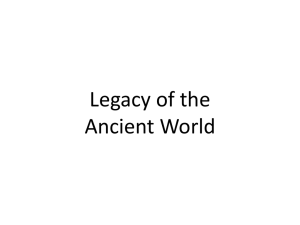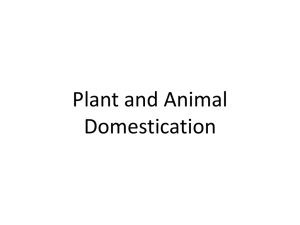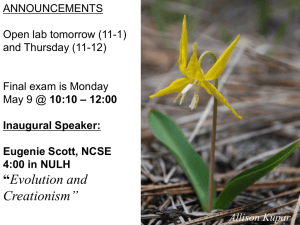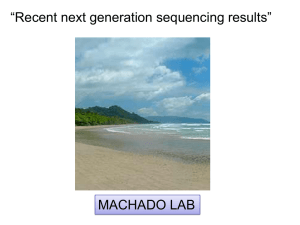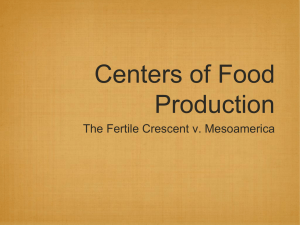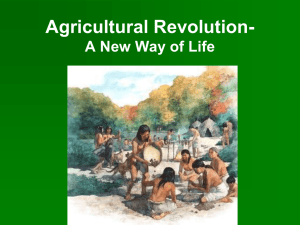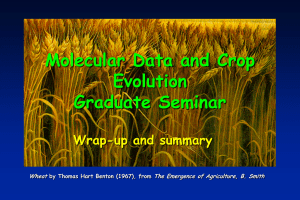Domestication genes in plants
advertisement
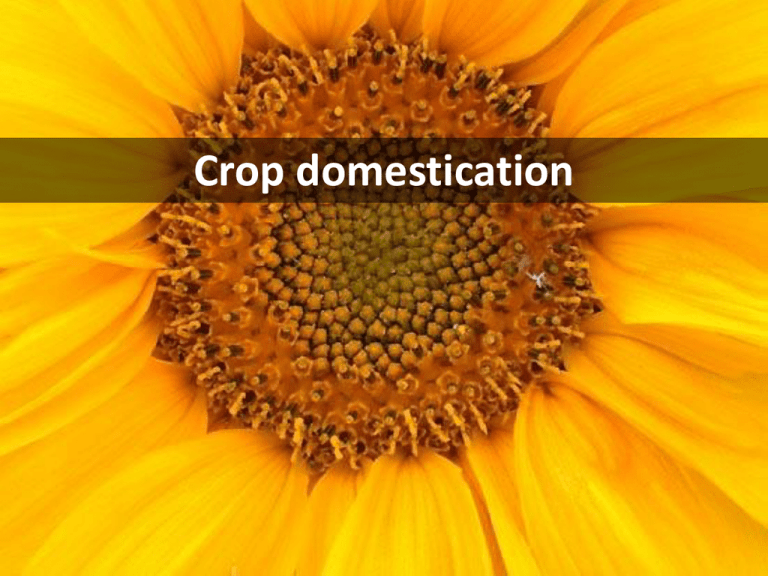
Crop domestication Centres of Plant Domestication • Concept first devised by Vavilov in 1919 • Archaeological evidence suggests that hunter-gatherers independently began cultivating food plants in 24 regions,….” (Purugannan and Fuller, 2009) Domestication ‘Domestication is the process by which humans actively interfere with and direct crop evolution.’ • It involves a genetic bottleneck: • Often only few genes are actively selected and account for large shifts in phenotype. • Crops exhibit various levels of domestication. What is a domestication syndrome? A domestication syndrome describes the properties that distinguish a certain crop from it’s wild progenitor. Typically such characteristics are: • larger fruits or grains • more robust plants • more determinate growth / increased apical dominance • loss of natural seed disperal • fewer fruits or grains • decrease in bitter substances in edible structures • changes in photoperiod sensitivity • synchronized flowering Tomato - Fewer and Larger Fruits Sunflowers - reduced branching, larger seeds, increased seed set per head Wheat - reduced seed shattering, increased seed size Squash – larger, fleshier fruits Corn – reduced fruitcase, softer glume, more kernels per cob, no dispersal, reduced branching, apical dominance Lettuce – leaf size/shape, fewer secondary compounds Rice – no shattering, larger grains Domestication is a process • The distinction ‘domesticated’ or ‘not domesticated’ is an oversimplification • Some crops have moved further along this process further than others. • We can recognize different levels of domestication • How can we decide which level? • Different domestication traits were selected for progressively •Distinction between selection under domestication vs. crop diversification more targeted, ‘conscious’ selection during diversification • ‘Slow’ rate of evolution of different domestication traits despite faster rates suggested by models • Artificial selection can be “similar across different taxa, geographical origins and time periods” • Parallel evolution for “sticky glutinous varieties” in rice and foxtail millets, all through selection at the waxy locus • Most QTL studies suggest that many domestication traits are controlled by a few genes of large effect – not though in sunflower • Population genomic studies in maize suggest 2 – 4% of genes show evidence of artificial selection Domestication of Maize How often has maize been domesticated? – Sampling (Matsuoka et al, 2002) How often has maize been domesticated? – Once. (Matsuoka et al, 2002) Tracking footprints of maize domestication and evidence for a massive selective sweep on chromosome 10 (Tian et al., 2009 PNAS) Teosinte branched 1 (tb1) • was identified as a major QTL controlling the difference in apical dominance between maize and its progenitor, teosinte (Doebley et al., 1997; Doebley, 2004) • is a member of the TCP family of transcriptional regulators, a class of genes involved in the transcriptional regulation of cell-cycle genes. •Differences in tb1 expression patterns between maize and teosinte indicate that human selection was targeted at regulatory differences that produced a higher level of tb1 message in maize. • Lack of any fixed amino acid differences between maize and teosinte in the TB1 protein supports this hypothesis. “For maize tb1 … [the selection coefficient] is in the range 0.05 to 0.2, comparable to cases of natural selection.” (Purugannan and Fuller, 2009) Teosinte glume architecture1 (tga1) • was identified as a QTL controlling the formation of the casing that surrounds the kernels of the maize ancestor, teosinte (Wang et al., 2005) • is a member of the squamosa-promoter binding protein (SBP) family of transcriptional regulators. • tga1 has phenotypic effects on diverse traits including cell lignification, silica deposition in cells, three-dimensional organ growth, and organ size •The difference in function between the maize and teosinte alleles of tga1 appears to be the result of a single amino acid change. The fact that there are no discernable differences in gene expression supports this interpretation. Domestication genes in plants Crop Diversification genes in plants The evolution of non-shattering in the archaeological record The genetic basis of the evolution of non-shattering Non-shattering is often regarded as the hallmark of domestication in most seed crops because it renders a plant species primarily dependent on humans for survival and propagation: • rice gene sh4 (similar to the genes encoding MYBlike transcription factors in maize) • rice quantitative trait locus (QTL) qSH1, which encodes a homeobox-containing protein • the wheat gene Q, which is similar to genes of the AP2 family in other plants • In sunflower likely controlled by multiple genes Domestication genes in plants • Maize and rice domestication seem to suggest few loci of large effect are important • Sunflower domestication seems to suggest many loci of small to intermediate effect are important • 9 domestication genes in plants so far, as well as 26 other loci known to underlie crop diversity • Of the 9 domestication loci, 8 encode transcriptional activators. • More than half of crop diversification genes encode enzymes. Domestication seems to be associated with changes in transcriptional regulatory networks, whereas crop diversification involves a larger proportion of enzymeencoding loci (lots of them loss-of-function alleles). The role of polyploidy in domestication Towards resolving the genetic basis of domestication in the Compositae Artificial selection through domestication but HOW ? Some fundamental questions in domestication genetics Which genes show strong signs of selection in crops? different Can we see common patterns in taxa that have been domesticated for similar purposes? Can we see dissimilar categories of genes under selection in different crop types despite their close phylogenetic relationship (e.g. sunflower and jerusalem artichoke)? Methodological ‘bottom-up’ approach Bioinformatics pipeline: 1.) Input: EST libraries of crop, progenitor and outgroup 2.) Genes that are orthologous in all taxa are identified 3.) These genes are scanned for signs of strong positive selection 4.) Such genes are compared to all known proteins in Arabidopsis 5.) Functional characteristics of best fits in Arabidopsis genomic database (TAIR) are annotated Some preliminary results Preliminary results from candidate domestication gene search in Compositae crops: • Several stress response genes are under selection in leaf and oil seed crops • Other interesting candidate domestication genes: safflower: fatty acid metabolism sunflower: nitrate assimilation Jerusalem artichoke: lateral root formation What to do with candidate genes? Confirm their role underlying traits - functional analysis (introgression/transgenes) - expression - population genetic work confirm associations with fitness association mapping with traits of interest What to do with candidate genes? Applications: breeding / improvement conservation of genetic diversity identification of taxon boundaries understanding adaptation/domestication comparative analysis – other taxa Crop improvement • Phenotype – based selection – Slow, ineficient but can be effective • Using genetics to inform breeding – Marker-assisted selection – Marker-assisted introgression • Transformation – Efficient (if you have the gene) but controversial Transgenics controversy • Advantages: – Targeted to specific gene – Any gene can be changed / introduced from any species – Fast and efficient • Disadvantages: – Safety issues – Regulations / legal issues – Requires expertise and technology Transgenics controversy • Advantages: – Huge improvements in phenotype of interest possible – Yield improvements – Health / nutrition benefits – Reduce herbicide / pesticide / fertilizer use – New products – pharmaceuticals, chemicals, etc. • Disadvantages: – Little regulation for health/environmental safety – Loss of genetic diversity – Reliance on big seed companies

